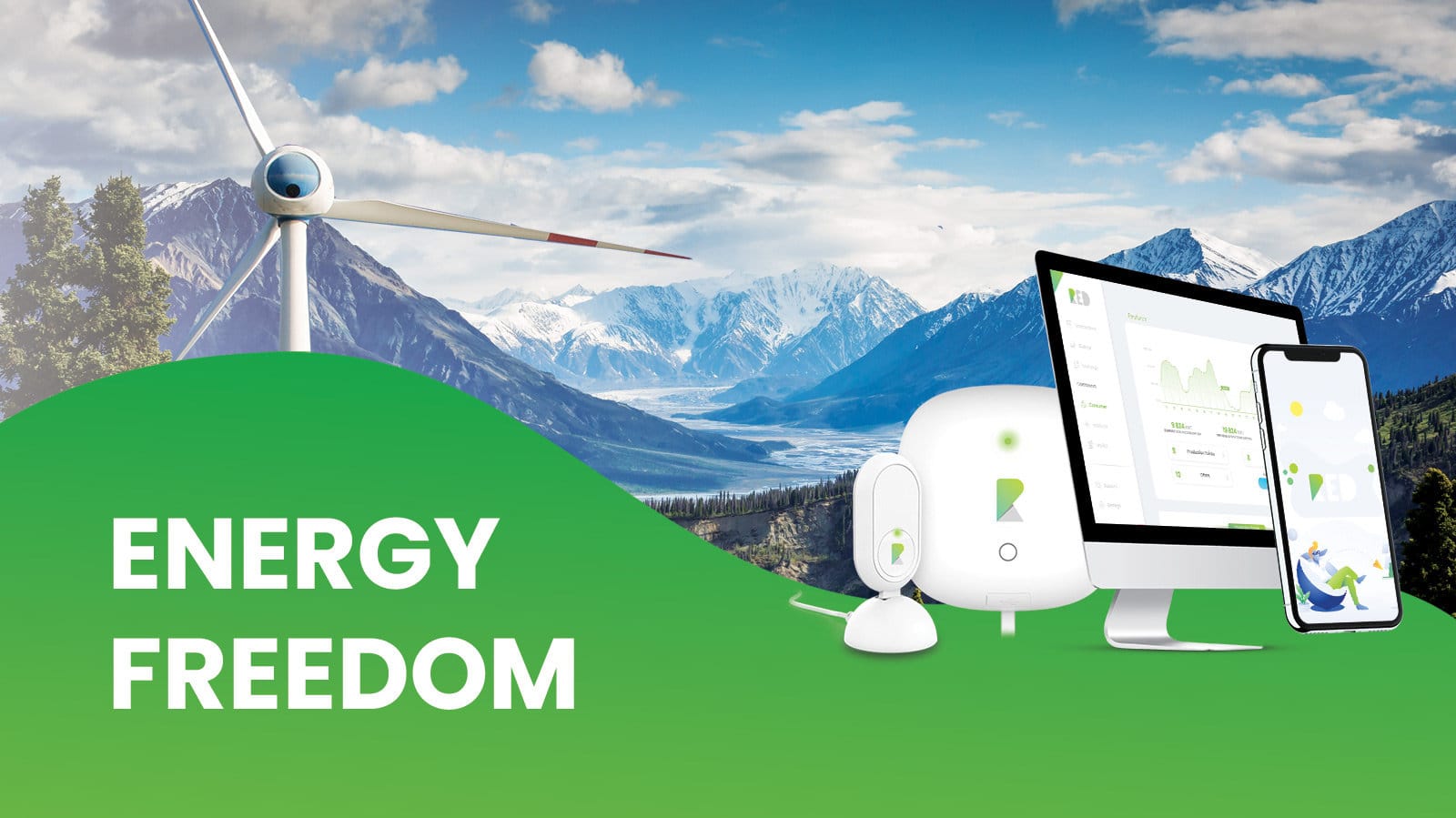“Simplicity in trading renewable energy is key towards a zero-carbon economy ”
Our team here at RED (Restart Energy Democracy) has been working around the clock to find the best possible solutions to a very complicated equation — the energy market structure equation.
First of all, I want to wish everyone a fantastic year full of accomplishments, both personal and professional. This year is very important for our project, but also for the human race because of the need to take urgent action in preventing climate change and global warming. It’s not just an opportunity but a responsibility to apply the lessons we learned in the last two years regarding a functional P2P energy marketplace. It is time to put them into practice for the greater good of our planet, our community, and our society.
A digital energy marketplace
As you all know, we’ve set out from the beginning to achieve something that has never been done before. We plan to transform the way energy works, tokenize using blockchain, and help consumers pay less and producers earn more by creating a framework for renewable energy producers to sell their electricity directly to final consumers. All of this in a new open and decentralized digital energy marketplace.
A custom-made blockchain
In this process, we created our own custom ultrafast blockchain (SWAZM) that can process up to 200,000 tx/s to serve the energy industry’s needs for speed, security, reliability, and interoperability with other blockchains. We also added a custom IoT hardware solution (RED Sensors) to track electricity consumption and production directly on the blockchain. This was done in record time considering the implications of linking hardware with blockchain and the business logic of physical electricity supply.
The way RED works today is very similar to a “sleeved PPA” model with several improvements and unique advantages like tracking energy on the blockchain.
In a sleeved PPA, an energy supplier (Restart Energy) handles the transfer of money and energy to and from a renewable energy producer on behalf of the buyer. The supplier (Restart Energy) takes the energy directly from the renewable energy producer and “sleeves” it to the Consumer at its point of intake, for a fee.
What problems is RED solving?
Since the 1990’s, dozens of nations have initiated deregulation of their energy markets. The trend toward privatization continued into the aughts, particularly in Europe, where EU directives were enacted to promote market liberalization.
The promise of deregulation was that robust competition would lead to service and cost improvements for consumers. In the subsequent years, however, smaller players have struggled to gain market traction. Hence, private monopolies have replaced state monopolies, depriving consumers of the benefits increased competition should bring.
Between 2011 and 2016, the market share of the three largest European retail energy suppliers fell by less than 4% to 80.6%. It indicates that deregulation has yet to make an impact. Due to a lack of competitive breadth, legacy players face little pressure to innovate, evolve their service offering or lower their prices. In fact, in many parts of the world, energy prices have actually increased.
Scaling the energy market
Entering the deregulated energy market and successfully scaling a private energy company from the ground up is extremely challenging. Startup costs are high on account of capital-intensive infrastructure demands and process automation. The latter is a requisite for any company that wishes to handle a large number of low-volume consumption orders typical in the retail energy sector.
While costs remain high for emergent producers, the market remains opaque for consumers, who are often unaware of the choices available to them. The sort of energy preferences that consumers might favor, such as selecting renewable sources over fossil fuels, are simply not available. Companies cannot scale through serving consumer preference for clean energy sources. The traditional energy supply model cannot facilitate transparency and accountability, either.
Governments have been aware of these challenges for some time, and have created subsidies to assist with renewable energy switching. At least until the necessary economies of scale are reached. Such measures, while well-intentioned, have had little impact, however, and few countries have come close to achieving grid parity with fossil fuels. With subsidies now decreasing, it is evident: a new approach is needed to realize the goal of a greener, less carbon-intensive society.
An efficient system of process automation in conjunction with a distributed energy development model, connecting end-users with producers, is long overdue.
Cost and regulatory barriers
Energy trading in most countries is highly regulated, technical, and capital intensive. For instance, let’s take the trading process on day-ahead markets. This process requires electricity producers who wish to sell power to the spot market to send their sale offers to the power exchange by noon the day before they deliver the power to the grid. It can eventually lead to erratic pricing in trading by energy providers.
There are also very tight physical parameters, such as frequency and voltage. The condition is to maintain these parameters when electricity is transported via the grid system, requiring continuous labor-intensive management.
Prosumers underpaid
The export tariffs prosumers earn from selling self-generated power to the grid are far less than the value realized by utility companies for reselling that same energy. In the UK, for instance, prosumers sell self-generated power at only 40% of its resale value.
Restart Energy Democracy’s Solution
RED Platform aims to democratize a sector burdened by bureaucracy and transaction costs. It puts effort in freeing up capital, helping consumers and small producers access an energy trading market, maximizing in this way their earnings.
RED will operate a retail energy P2P marketplace that can be accessed by all participants in the energy market. This is in contrast with the current situation where only big players can access the market at a wholesale level due to high access costs and complicated technical barriers.
It works by providing a marketplace infrastructure with blockchain security, transparency, and accountability for consumers, producers, and suppliers to transact P2P renewable energy in the form of sleeved or virtual PPA’s.
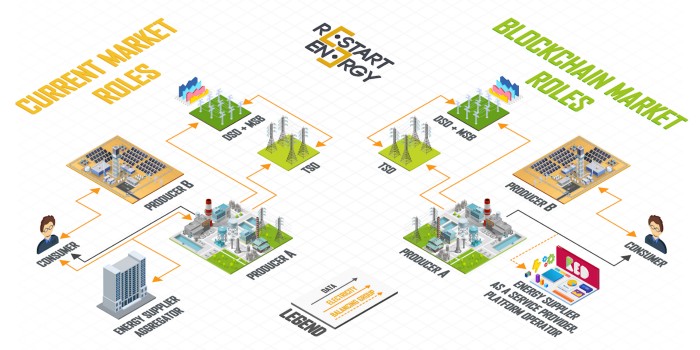
Today, buying or selling energy takes place on specialized energy exchanges, between suppliers, traders, and producers using standardized products of different profiles. The participation cost on these exchanges, as well as the level of technicality required, are significant. They impede the participation of SMEs and smaller consumers/prosumers or producers, for which there is currently no market to allow direct trading of renewable electricity for retail.
A link between energy producers and final consumers
RED solves this problem by creating the infrastructure that allows the opening and operation of a new market for energy retail with blockchain transactions directly between renewable energy producers and final consumers.
In liberalized markets globally, and under the applicable laws in each jurisdiction, only licensed energy suppliers deliver electricity for final consumers. Most countries on the world map use an energy system based on the existence of the parties responsible for balancing (BRP’s). These parties receive the consumption and production forecast from suppliers and producers and aggregate them. Afterward, they send the schedules to the system operators (TSO’s). RED needs to be able to operate under these market conditions by bringing added value to all the parties involved from producers to consumers, suppliers and system operators.
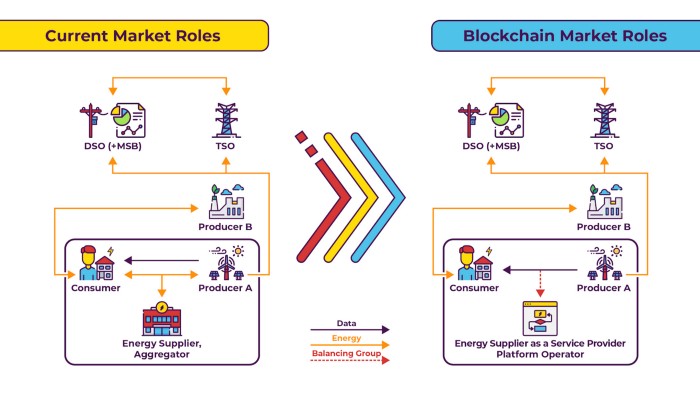
Restart Energy’s mission is to create a global market for decentralized renewable energy trading for retail at much lower costs that allows the participation of all consumers and producers regardless of size.
Why now?
Renewable energy demand is rapidly rising
Public concern about the environment is placing pressure on businesses and politicians to provide greater leadership on climate change. A recent survey of corporations showed a “rapidly growing appetite for renewables,” while 53% of residential respondents indicated that it is extremely or very important that part of their electricity supply comes from renewable sources. 48% of business respondents stated that they are working to procure more electricity from renewable sources.
European political policy is strongly in favor of renewable technology, setting a goal of raising renewable energy production to at least 27% by 2030. This aligns with the EU’s twin objectives of increasing the security of Europe’s energy supply and reducing greenhouse gas emissions.
It is evident that renewables will play an increasing role in meeting Europe’s energy demand, which will grow by one fifth to hit 12.4% by 2023. Renewables will be the fastest-growing sector in electricity production, comprising close to 30% of power demand by 2023, from 24% in 2017. Renewables will account for more than 70% of global electricity generation growth during this period.
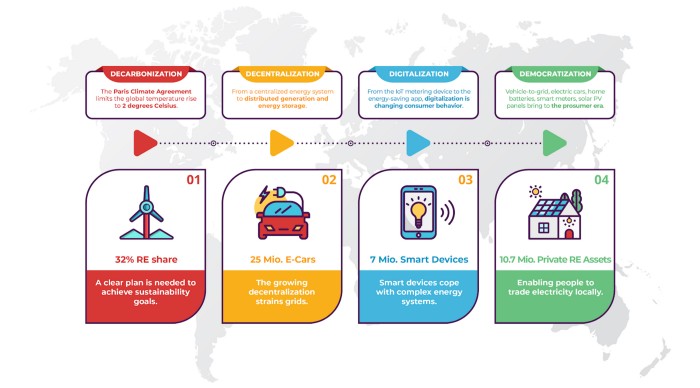
Global deregulation ramps up
Three-quarters of the world’s energy markets are now deregulated, creating an opportunity for new firms to enter the space, providing a greater degree of competition and furthering innovation. Despite deregulation permeating many of the world’s largest markets, legacy players hold the lion’s share of the global energy supply business. There remains great untapped potential for fresh thinking and forward-looking energy provider to capitalize on the sizeable opportunity that deregulation presents.
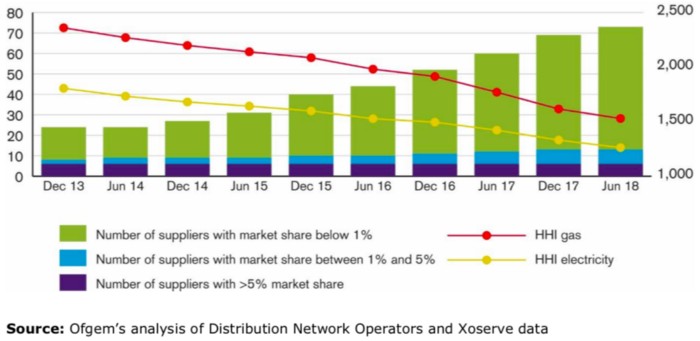
Falling cost of renewable energy production assets
Diminishing hardware costs are driving growth in the number of prosumers (households or businesses that generate their own energy). Renewables have been consistently falling in price, with the cost of solar panels dropping by 70% over the last decade. The declining costs of wind and solar generation and advances in battery storage technology were key drivers in the growth of the renewables sector in 2018.
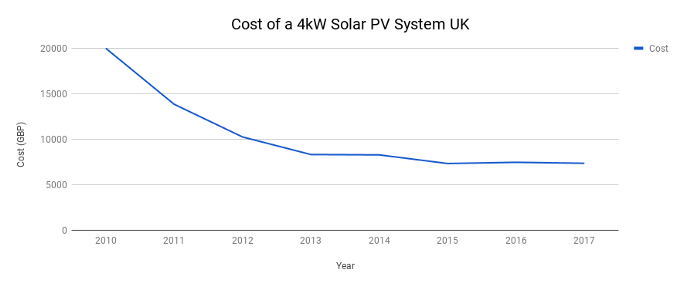
Increase in electric vehicles
Electric vehicles will increase from 3 million to 125 million by 2030. In order to maximize the decarbonization benefits touted by the e-mobility sector, electricity from the grid has to come from clean, sustainable sources.
Falling cost of energy storage
The advancement of the current battery technology plays an effective role in the energy mix, especially as a means to supplement electricity during times of peak demand, or during short-term dips in renewable energy production. The energy storage market is now witnessing significant investment with €62.7B of funding predicted by 2024.
Rise of the sharing economy
Multiple industries establish a sharing economy and firmly entrench it in consumer consciousness. Sharing economy services like Airbnb, Uber and Lyft have mushroomed over the last few years and are now part of the fabric of everyday life. In most developed and developing countries around the world, we will discover a paradigm of buying, selling, or renting underutilized assets. Selling surplus energy capacity is the next phase of the sharing economy, with the monetary savings bolstered by the environmental benefits of energy conservation. A number of companies are now developing solutions that allow consumers to trade energy peer-to-peer.

The emergence of the Internet of Energy
The energy grid is growing smarter, driven by advanced sensors and metering technology, intelligent devices, ultra-fast communications, and real-time processing of vast quantities of data. As the Internet of Things (IoT) expands to accommodate the energy sector, better grid management will maximize the potential of renewables, optimizing the generation, transmission, storage, and utilization of electricity.

Time for change
On both the consumption and production sides of the market, households and businesses receive poor services from utility companies. Energy costs are unfairly high and prosumers are paid too little for their efforts. There is a requirement for a new system that gives consumers direct access to more trackable, cheaper energy, while providing producers with added incentives for faster renewable energy deployment. There is a clear demand for a P2P trading platform that fulfills these requirements, giving prosumers more while lowering costs for consumers.
The RED Platform
The RED Platform is at the heart of Restart Energy’s business strategy. The blockchain-based P2P energy trading marketplace connects energy producers, consumers and prosumers, and will eventually become available in over 35 countries with deregulated retail markets.
RED automates the tracking and trading of energy with increased efficiencies, yielding cost savings on both sides of the market. By reducing the bureaucratic and economic transaction costs of the retail energy business, RED empowers households and businesses to become self-sustaining energy prosumers within their communities.
RED Platform users enter into a supply contract or power purchase agreement with Restart Energy, which will allocate the energy accordingly. When a consumer subscribes to a producer’s offer, their meters are paired, and the renewable energy is allocated in real-time as payment in the form of digital currency flows from consumer to producer simultaneously. Restart Energy accounts for these transactions as the energy supplier.
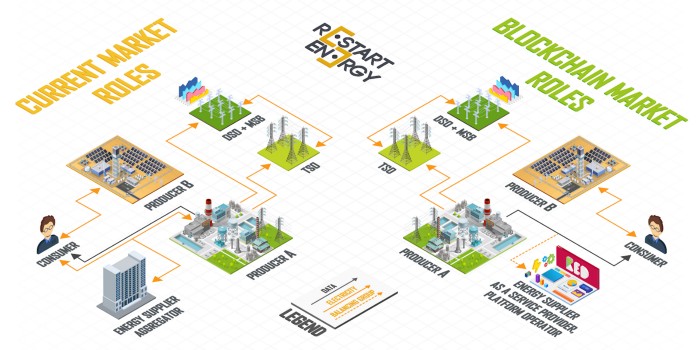
Production and consumption of renewable energy
Producers can sell their energy at higher than wholesale prices to consumers who will save a similar amount compared to utilizing the existing grid infrastructure. RED achieves these savings through the elimination of intermediaries and unnecessary administrative costs, exacerbated by the utility monopolies having little incentive to provide more competitive rates.
The RED Platform realigns incentives around the adoption of renewable energy production and consumption. By unlocking new business opportunities and reducing the costs of trade, consumers can benefit from reliable supply and better rates. Meanwhile, producers can maintain profitability without compromising on service quality or arbitrarily hiking up prices.
About the Author:
Armand Doru Domuța is the Chairman and CEO of Restart Energy Innovative Technologies AG and the President of the Romanian Blockchain Association
He scaled Restart Energy into one of the fastest-growing energy companies in the EU and the main private alternative energy and gas supplier for 35,000 households and SME’s in Romania & Serbia with several international subsidiaries. Developed 500 MW of renewable energy projects including forecasting, dispatching, balancing, and cross-border energy trading. Designed the RED Platform digital energy marketplace that allows energy to be exchanged freely between consumers and producers. Dreams to bring people Energy Freedom!
